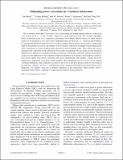Subleading power corrections for N-jettiness subtractions
Author(s)
Rothen, Lorena; Tackmann, Frank J.; Moult, Ian James; Stewart, Iain W; Zhu, HuaXing
DownloadPhysRevD.95.074023.pdf (1.422Mb)
PUBLISHER_POLICY
Publisher Policy
Article is made available in accordance with the publisher's policy and may be subject to US copyright law. Please refer to the publisher's site for terms of use.
Terms of use
Metadata
Show full item recordAbstract
The N-jettiness observable T[subscript N] provides a way of describing the leading singular behavior of the N-jet cross section in the τ=T[subscript N]/Q→0 limit, where Q is a hard interaction scale. We consider subleading-power corrections in the τ≪1 expansion, and employ soft-collinear effective theory to obtain analytic results for the dominant α[subscript s]τlnτ and α[superscript 2][subscript s]τln[superscript 3]τ subleading terms for thrust in e[superscript +]e[superscript -] collisions and 0-jettiness for q[bar over q]-initiated Drell-Yan–like processes at hadron colliders. These results can be used to significantly improve the numerical accuracy and stability of the N-jettiness subtraction technique for performing fixed-order calculations at next-to-leading order and next-to-next-to-leading order. They reduce the size of missing power corrections in the subtractions by an order of magnitude. We also point out that the precise definition of N-jettiness has an important impact on the size of the power corrections and thus the numerical accuracy of the subtractions. The sometimes employed definition of N-jettiness in the hadronic center-of-mass frame suffers from power corrections that grow exponentially with rapidity, causing the power expansion to deteriorate away from central rapidity. This degradation does not occur for the original N-jettiness definition, which explicitly accounts for the boost of the Born process relative to the frame of the hadronic collision, and has a well-behaved power expansion throughout the entire phase space. Integrated over rapidity, using this N-jettiness definition in the subtractions yields another order of magnitude improvement compared to employing the hadronic-frame definition.
Date issued
2017-04Department
Massachusetts Institute of Technology. Center for Theoretical Physics; Massachusetts Institute of Technology. Department of PhysicsJournal
Physical Review D
Publisher
American Physical Society
Citation
Moult, Ian et al. “Subleading Power Corrections for N -Jettiness Subtractions.” Physical Review D 95.7 (2017): n. pag. © 2017 American Physical Society
Version: Final published version
ISSN
2470-0010
2470-0029